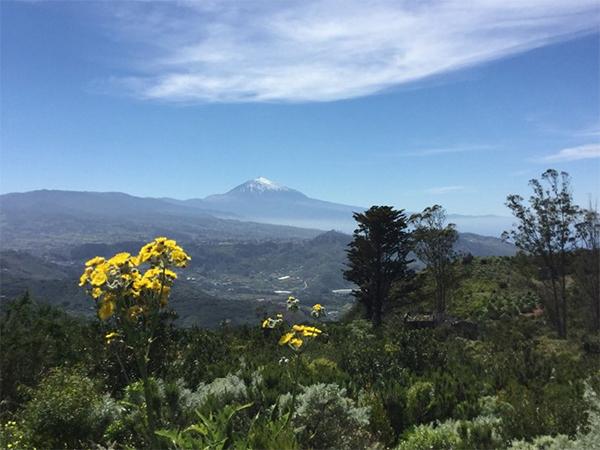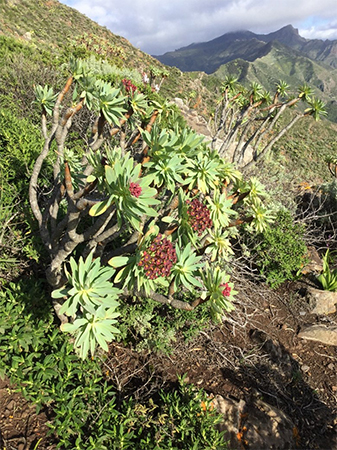Evolutionary winners are ecological losers among oceanic island plants
Evolution of multiple species from a single colonizer is something that has happened repeatedly on oceanic islands across the world. Such radiations, can lead to tens or even hundreds of distinct species, often occupying a range of very different habitats and ecological niches. These patterns have inspired interest in islands as model systems ever since Charles Darwin's observations on the Galapagos finches in the mid-19th Century. The popular description of such radiations as involving the 'survival of the fittest' might lead us to expect that these 'evolutionary winners' will be species so well-tuned to their island environments that they should also be locally successful and abundant. That is, they should be winners both in evolutionary and ecological terms.

Image: Tenerife spans a great range in elevation (max 3715m asl), and offers a great array of ecosystem types, within which endemic species are found at all elevations, but those that are part of large insular radiations are mostly rare, except on steep slopes and at high elevation.
In a new study in Journal of Biogeography, an international team led by José María Fernández-Palacios of La Laguna University, Tenerife, has shown that it may not be so simple. They gathered data for the distribution and abundance of all native plant species across each of the major ecosystem types of the Canary Islands. They found that most of the species that have arisen through radiation (the 'evolutionary winners') are actually rather rare and occupy marginal spaces.
"We categorised the species into the major elevational ecosystem types," explained Dr Rudi Otto, a co-author of the study, "including open habitats and closed forest and we found that it was only in the highest mountain scrub and on steep rocky ground that species representing the Canarian radiations were really important or dominant elements."
Professor Robert Whittaker (Oxford University), also a co-author on the paper comments that, "When we were working on the project, we realised that one of the founding fathers of plant geography, Joseph Dalton Hooker, had identified somewhat similar patterns for the nearby archipelago of Madeira in a lecture on island plants given in Nottingham in 1866. He described how the plants shared with mainland Europe tended to be the most abundant, while the species unique or endemic to Madeira were least common in the vegetation. Our analysis goes further than Hooker's observations in showing that it is the groups that have diversified most within the islands that seem to produce 'ecologically losers', species that are only abundant in marginal, open and rather impermanent habitats within the islands."
While the new paper quantifies these distributional patterns clearly, it leaves open the question of why these locally produced species have not spread and become dominants more often? This remains an enigma. But the authors found two important clues.
First, many of the diversified plant lineages are relative late-comers: invasion of the already well-stocked lower elevational ecosystems may have been difficult for the newly arisen species, whereas the younger, often disturbed high elevation systems and steeper rocky terrain have provided more opportunities for evolutionary experiment.
Second, successful plant diversification on these islands has mostly involved small shrubs, and quite a lot of them possess another classic syndrome of plant evolution on islands, a transition from herbaceous ancestors to woody descendents, which permits greater size and longevity.
Oceanic islands remain important natural laboratories for the study of evolutionary ecology, but many of the endemic plant species found on these islands are now threatened with extinction through the many environmental pressures generated by human societies, including habitat conversion and the introduction of non-native species.
Photographs © Robert J. Whittaker, March 2018
Further information
- Fernández-Palacios, J.M., Otto, R., Borregaard, M.K., Kreft, H., Price, J.P., Steinbauer, M.J., Weigelt, P. and Whittaker, R.J. (2021) Evolutionary winners are ecological losers among oceanic island plants. Journal of Biogeography.
- Prof Robert J Whittaker
Evolutionary winners are ecological losers among oceanic island plants

Evolution of multiple species from a single colonizer is something that has happened repeatedly on oceanic islands. Such radiations, can lead to tens or even hundreds of distinct species, often occupying a range of very different habitats with the expectation that these 'evolutionary winners' will be species so well-tuned to their island environments that they should also be locally successful and abundant. In a new study in Journal of Biogeography, an international team including Prof Rob Whittaker, has shown that it may not be so simple.





